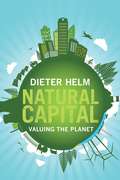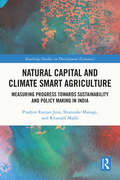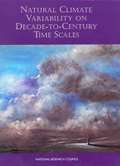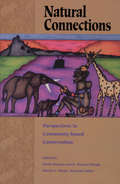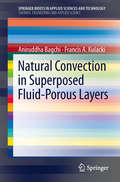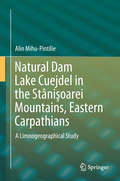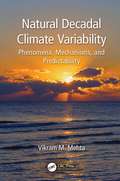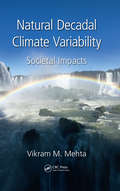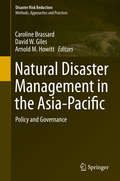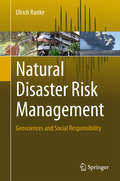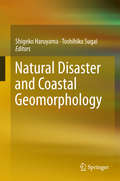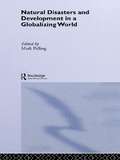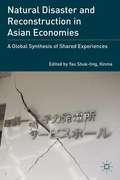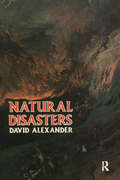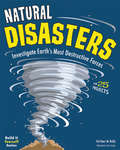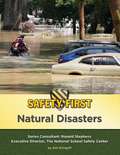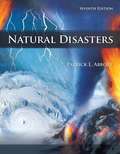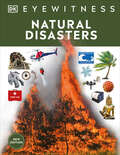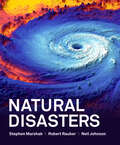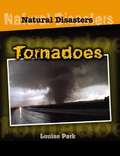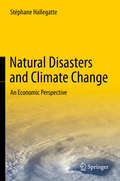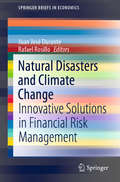- Table View
- List View
Natural Capital
by Dieter HelmNatural capital is what nature provides to us for free. Renewables like species keep on coming, provided we do not drive them towards extinction. Non-renewables like oil and gas can only be used once. Together, they are the foundation that ensures our survival and well-being, and the basis of all economic activity. In the face of the global, local, and national destruction of biodiversity and ecosystems, economist Dieter Helm here offers a crucial set of strategies for establishing natural capital policy that is balanced, economically sustainable, and politically viable. Helm shows why the commonly held view that environmental protection poses obstacles to economic progress is false, and he explains why the environment must be at the very core of economic planning. He presents the first real attempt to calibrate, measure, and value natural capital from an economic perspective and goes on to outline a stable new framework for sustainable growth. Bristling with ideas of immediate global relevance, Helm s book shifts the parameters of current environmental debate. As inspiring as his trailblazing "The Carbon Crunch," this volume will be essential reading for anyone concerned with reversing the headlong destruction of our environment. "
Natural Capital and Climate Smart Agriculture: Measuring Progress towards Sustainability and Policy Making in India (Routledge Studies in Development Economics)
by Shunsuke Managi Pradyot Ranjan Jena Ritanjali MajhiIndia is the fastest growing and the world’s third-largest economy in terms of GDP in PPP terms. Sustainable development of India will ensure the welfare of the inhabitants of this most populated country. This book assesses trends of natural capital and areas of improvement through climate resilient agricultural adaptation in India.The book looks at how the agricultural sector can become more climate resilient to ensure food security and human capital development. It also suggests a policy framework towards climate-resilient agricultural development. It outlines determinants of climate-smart agricultural practices and their impact on agricultural yield, biodiversity, and food security, and as well as outreach activities for wider collaboration from around the world.This book will interest those who are researching accounting natural capital impacts of climate-resilient agriculture and 2030 SDGs.
Natural Climate Variability On Decade-to-Century Time Scales
by Climate Research CommitteeThis volume reflects the current state of scientific knowledge about natural climate variability on decade-to-century time scales. It covers a wide range of relevant subjects, including the characteristics of the atmosphere and ocean environments as well as the methods used to describe and analyze them, such as proxy data and numerical models. They clearly demonstrate the range, persistence, and magnitude of climate variability as represented by many different indicators. Not only do natural climate variations have important socioeconomic effects, but they must be better understood before possible anthropogenic effects (from greenhouse gas emissions, for instance) can be evaluated. A topical essay introduces each of the disciplines represented, providing the nonscientist with a perspective on the field and linking the papers to the larger issues in climate research. In its conclusions section, the book evaluates progress in the different areas and makes recommendations for the direction and conduct of future climate research. This book, while consisting of technical papers, is also accessible to the interested layperson.
Natural Connections: Perspectives In Community-Based Conservation
by Michael Wright Charles Zerner John Robinson Jonathan Otto Richard Donovan David WesternBoth realism and justice demand that efforts to conserve biological diversity address human needs as well. The most promising hope of accomplishing such a goal lies in locally based conservation efforts -- an approach that seeks ways to make local communities the beneficiaries and custodians of conservation efforts.Natural Connections focuses on rural societies and the conservation of biodiversity in rural areas. It represents the first systematic analysis of locally based efforts, and includes a comprehensive examination of cases from around the world where the community-based approach is used. The book provides: an overview of community-based conservation in the context of the debate over sustainable development, poverty, and environmental decline case studies from the developed and developing worlds -- Indonesia, Peru, Australia, Zimbabwe, Costa Rica, the United Kingdom -- that present detailed examples of the locally based approach to conservation a review of the principal issues arising from community-based programs an agenda for future action
Natural Convection in Superposed Fluid-Porous Layers
by Francis A. Kulacki Aniruddha BagchiNatural Convection in Composite Fluid-Porous Domains provides a timely overview of the current state of understanding on the phenomenon of convection in composite fluid-porous layers. Natural convection in horizontal fluid-porous layers has received renewed attention because of engineering problems such as post-accident cooling of nuclear reactors, contaminant transport in groundwater, and convection in fibrous insulation systems. Because applications of the problem span many scientific domains, the book serves as a valuable resource for a wide audience.
Natural Dam Lake Cuejdel in the Stânişoarei Mountains, Eastern Carpathians
by Alin Mihu-PintilieThis book presents an interdisciplinary study of Lake Cuejdel, one of the youngest natural dam lakes in Romania. Even though the overall study has a strong geographical approach, it also includes limnological and hydrological studies. The lake was formed in two phases: Initially a small lake appeared in 1978, and then in 1991 a major landslide occurred that blocked the Cuejdel brook and a larger lake was formed.The book covers various topics, including the lacustrine basin, the geological setting, analyses of the physical-chemical parameters, water dynamics, flora and fauna and lake management.This book is of interest for those working in freshwater science and ecology, physical geography, hydrology and limnology..
Natural Decadal Climate Variability: Phenomena, Mechanisms, and Predictability
by Vikram M. MehtaNatural decadal climate variability (DCV) and its interactions with anthropogenic climate change (ACC) are vitally important to understand to predict the future of the Earth’s climate. This book, after familiarizing readers with the importance of understanding and predicting DCV phenomena and its distinction from ACC phenomena, comprehensively explains the physics of DCV, integrating paleoclimate proxy and modern instrument-based data and simulations with climate models. Features of this book: Uniquely focuses on natural DCV, its physics, and its predictability Presents an integrated view of DCV phenomena based on approximately 700 peer-reviewed publications cited in the book Includes research on influences of decadal variability in solar emissions on the Earth’s climate, with a historical perspective going back several centuries Describes progress in decadal climate predictability and prediction research, with a historical perspective on weather and climate predictability research This book is an excellent resource for graduate students, faculty members and other teachers and researchers, and anyone who is interested in learning about a very important component of the puzzle of the changing climate. "This book provides a comprehensive review…. Highlighted throughout the book are potential links between DCV and solar variability, a fascinating topic that has engaged our minds for centuries. Written by an expert with more than 30 years’ experience, this book should be an invaluable resource for students and researchers interested in how our climate will evolve over the coming decades." Doug Smith, Decadal Climate Prediction Leader, Meteorological Office Hadley Centre, UK "This book is a tour de force by the author who has spent his career studying decadal climate variability. He brings new insights to the vast scope of this topic, providing clearly understandable descriptions of the various aspects." Gerald Meehl, Senior Scientist, National Center for Atmospheric Research, Colorado, USA
Natural Decadal Climate Variability: Societal Impacts (Drought and Water Crises)
by Vikram M. MehtaNatural Decadal Climate Variability: Societal Impacts is an important work for understanding the natural decadal climate variability (DCV), a phenomenon which has made long lasting impacts on civilizations, especially on water availability and agriculture. This book comprehensively covers multiyear to decadal variations in instrument measured precipitation and temperature, water availability and river flows, crop production, agricultural irrigation, inland water-borne transportation, hydroelectricity generation, and fish and crustacean captures since the 1960s. A longer term perspective is provided with the use of multi-century data on dry and wet epochs based on tree ring information, and corroborating evidence from other literature. This valuable work will benefit climate scientists, meteorologists, hydrologists, agronomists, water transportation planners, resource economists, policymakers, professors, and graduate students and anyone else who has an interest in learning how natural climate phenomena has influenced societies for at least the past 1000 years.
Natural Disaster Management in the Asia-Pacific
by Caroline Brassard Arnold M. Howitt David W. GilesThe Asia-Pacific region is one of the most vulnerable to a variety of natural and manmade hazards. This edited book productively brings together scholars and senior public officials having direct experience in dealing with or researching on recent major natural disasters in the Asia-Pacific. The chapters focus on disaster preparedness and management, including pre-event planning and mitigation, crisis leadership and emergency response, and disaster recovery. Specific events discussed in this book include a broad spectrum of disasters such as tropical storms and typhoons in the Philippines; earthquakes in China; tsunamis in Indonesia, Japan, and Maldives; and bushfires in Australia. The book aims to generate discussions about improved risk reduction strategies throughout the region. It seeks to provide a comparative perspective across countries to draw lessons from three perspectives: public policy, humanitarian systems, and community engagement.
Natural Disaster Risk Management
by Ulrich RankeThis textbook provides a thorough introduction to natural disaster risk management. Many aspects of disaster risk management, such as those involved in earthquakes, volcanic eruptions, floods, avalanches and mudslides call for similar prevention and preparedness instruments, management concepts, and countermeasures. This textbook assumes the viewpoint of a regional disaster risk manager who is responsible for a certain area, and for making the lives of the people who live there safer, regardless of the type of natural disaster that may occur. The same holds true for boosting preparedness and awareness in the population at risk. The book includes numerous examples of hazard mitigation concepts and techniques, as well as ways of intensively involving the local population in prevention schemes at an early stage. Furthermore, it provides an in-depth examination of the function of risk communication, both as an instrument for disseminating official information and as a function of public media. In closing, a chapter on risk splitting offers insights into insurance-based models for risk financing. This comprehensive book is a must-read for all students, researchers and practitioners dealing with natural disaster risk management.
Natural Disaster and Coastal Geomorphology
by Shigeko Haruyama Toshihiko SugaiThis book deals with the Tsunami intrusion in the lower plain in the Tohoku region and role played by the coastal and fluvial landforms in the damages. The land-use patterns and the recent urbanization has also been partly responsible for a risk level enhancement. The 2011 East Japan Earthquake and Tsunami has violently hit the coastal plain in the Tohoku and Kanto regions. The coastal geomorphology of these regions have played an important role in the impacts of this natural disaster. The authors introduce tectonic settings, explain and assess these different risks, and discuss future disaster prevention and mitigation planning.
Natural Disaster and Development in a Globalizing World
by Mark PellingThe number of humanitarian disasters triggered by a natural hazard has doubled every decade since the 1960s. At the same time, the global economic growth rate per capita is twice its 1960s value. Does this mean economic growth is independent of the impacts of natural disaster? Natural Disaster and Development in a Globalizing World is the first book to acknowledge the full implications of globalization for disaster and development. The contributors to this book fully examine: global processes and how they might affect disaster risk at the global scale. links between international issues - such as diplomatic relations, the growth of non-governmental organizations and the health of the international insurance industry - and disaster risk the interaction of these large scale forces with local conditions through case study analysis of individual disaster events. In his revealing work, author Pelling makes clear the links between global scale processes and local experiences of disaster, and underlies the difficulty of attributing blame for individual disasters on specific global pressures. He argues that action to reduce disaster must be coordinated at the local, national and global scales and that there is a need for greater integration across the physical and social sciences. In this context, the human rights agenda is seen as a way of moving disaster reduction efforts forward.
Natural Disaster and Reconstruction in Asian Economies
by Yau Shuk-Ting KinniaBased on conference proceedings presented at The Chinese University of Hong Kong in November 2012, Natural Disaster and Reconstruction in Asian Economies offers leading insight into and viewpoints on disasters from scholars and journalists working in Japan, China, the United States, and Southeast Asia.
Natural Disasters
by David AlexanderAs a well balanced and fully illustrated introductory text, this book provides a comprehensive overview of the physical, technological and social components of natural disaster. The main disaster-producing agents are reviewed systematically in terms of geophysical processes and effects, monitoring, mitigation and warning. The relationship between disasters and society is examined with respect to a wide variety of themes, including damage assessment and prevention, hazard mapping, emergency preparedness, the provision of shelter and the nature of reconstruction. Medical emergencies and the epidemiology of disasters are described, and refugee management and aid to the Third World are discussed. A chapter is devoted to the sociology, psychology, economics and history of disasters.; In many parts of the world the toll of death, injury, damage and deprivation caused by natural disasters is becoming increasingly serious. Major earthquakes, volcanic eruptions, droughts, floods and other similar catastrophes are often followed by large relief operations characterized by substantial involvement of the international community. The years 1990-2000 have therefore been designated by the United Nations as the International Decade for Natural Disaster Reduction.; The book goes beyond mere description and elevates the field of natural catastrophes to a serious academic level. The author's insights and perspectives are also informed by his practical experience of being a disaster victim and survivor, and hence the unique perspective of a participant observer. Only by surmounting the boundaries between disciplines can natural catastrophe be understood and mitigation efforts made effective. Thus, this book is perhaps the first completely interdisciplinary, fully comprehensive survey of natural hazards and disasters. It has a clear theoretical basis and it recognizes the importance of six fundamental approaches to the field, which it blends carefully in the text in order to avoid the partiality of previous works. It covers the earth and social sciences, as well as engineering, architecture and development studies. This breadth is made possible by virtue of a strong emphasis on simple principles of the interaction of geophysical agents with human vulnerability and response.; All students of environmental sciences/studies and geography should find this book useful. It is an introductory text which treats this dramatic subject area as something demanding serious academic treatment and not just as an assemblage of horror stories.; This book is intended for undergraduate students in geography and environmental studies/sciences. The book should also appeal to any professional or researcher concerned with man- environment relations, whether in social science or natural science or engineering.
Natural Disasters
by Kathleen M Reilly Tom CasteelWhen natural disasters happen they grab headlines around the world. People, creatures, and the environment are all impacted when nature gets out of control. Natural disasters can be upsetting to live through, but scientists today better understand their causes and how we can protect ourselves and others. Natural Disasters: Investigate Earth's Most Destructive Forces with 25 Projects teaches readers about some of the natural disasters throughout history, what caused them, their impact on civilizations, and how people today cope with natural disasters. Readers of this book will make their own shake tables, create a cake batter lava flow, invent a wind tunnel, and experiment with avalanches. These hands-on activities engage readers and add depth to the text while ensuring that the learning is made lasting and fun.
Natural Disasters
by Kim EtingoffStorms, tornados, floods, wildfires--the world is full of natural disasters that do terrible damage to our homes, towns, and cities. Knowing how to prepare for a natural disaster and what you can do if one does happen is the best way to keep yourself safe.
Natural Disasters
by Patrick L. AbbottNatural Disasters, 12th edition focuses on explaining how the normal processes of Earth concentrate their energies and deal heavy blows to humans and their structures. Students have a natural curiosity about natural disasters and why they occur. This text explains why natural disasters occur by interweaving the themes of Energy sources, Plate tectonics, Climate change, Earth Processes, Geologic time, the complexities of multiple variables operating simultaneously throughout the text.
Natural Disasters (7th edition)
by Patrick Leon AbbottNatural Disasters, 7th edition, focuses on how the normal processes of the Earth concentrate their energies and deal heavy blows to humans and their structures. It is concerned with how the natural world operates and, in so doing, kills and maims humans and destroys their works. Throughout the book, certain themes are maintained: energy sources underlying disasters plate tectonics and climate change; earth processes operating in rock, water, and atmosphere; significance of geologic time; complexities of multiple variables operating simultaneously; detailed and readable case studies.
Natural Disasters (DK Eyewitness Books)
by Claire WattsContains information on tsunamis, earthquakes, landslides, hurricane and other natural disasters.
Natural Disasters (DK Eyewitness)
by DKDiscover the awesome power of nature in this visual guide to the dynamic natural phenomena across our planet.Become an eyewitness to the weird and wonderful ways of our world, from tsunamis to tornadoes, and discover nature's awesome potential with this Eyewitness guide. See how earthquakes, floods and hurricanes affect what lies in their path, and what measures we can use to protect ourselves from Mother Nature. Follow the journey of some of the most catastrophic disasters, and witness the rescue operations that followed. Learn, too, about the equipment used to predict natural disasters, from tsunami magnitude to the earthquake Richter scale and how studies help predict hurricanes, prevent avalanches, control wildfires, and survive earthquakes.Throughout the pages of this newly- revised incredible history book, you can expect to find: -Up to 20 percent new images, including photography and updated diagram-All information updated by expert consultants-Packed with amazing facts, infographics, statistics, and timelines-Includes brand new eyewitness accounts from experts in the fieldThis museum in a book uses striking full-color photographs and illustrations to explore the ancient legends linked to many natural disasters and explains how human activities have caused many other disasters in recent times. A timeline tracing some of the most devastating disasters in history, record-breaking facts, and a guide to some useful online resources makes this a must-have volume for curious children aged 9+ with a thirst for knowledge and learning, alongside teachers, parents and librarians.So, what&’s new? Part of DK&’s best-selling Eyewitness series, this popular title has been reinvigorated for the next generation of information-seekers and stay-at-home explorers, with a fresh new look, up to 20 percent new images, including photography and updated diagrams, updated information, and a new &“eyewitness&” feature with fascinating first-hand accounts from experts in the field.Explore the series!Globally, the Eyewitness series has sold more than 50 million copies over 30 years. Join the journey to combat climate change with Eyewitness Climate Change or take a trip aboard the most famous ship in history with Eyewitness Titanic.
Natural Disasters (First Edition)
by Stephen Marshak Neil Johnson Robert RauberA vibrant introduction to the science and societal impacts of disasters. As our planet changes and human population grows, students will see new examples every year of the devastating impact that geologic and atmospheric disasters have on communities. Through vibrant and detailed visuals, engaging writing, and extended case studies, Natural Disasters helps explain the science behind these catastrophes and the societal factors that shape our responses. Step-by-step art makes key concepts accessible to all students. And two case studies in every chapter—covering one North American and one global example and reinforced through online Guided Learning Explorations—get students examining the societal factors that help shape how communities deal with these disasters. This purchase offers access to the digital ebook only.
Natural Disasters Tornadoes
by Louise ParkNatural Disasters: Tornadoes presents the basic scientific principles of how and why tornadoes occur. Case studies of actual events, prevention and warning systems now designed, are both used to show readers the interaction of natural science and human inventiveness .
Natural Disasters and Adaptation to Climate Change
by Sarah Boulter Jean Palutikof David John Karoly Daniela Guitart Sarah Boulter Jean Palutikof David John KarolyThis volume presents eighteen case studies of natural disasters from Australia, Europe, North America and developing countries. By comparing the impacts, it seeks to identify what moves people to adapt, which adaptive activities succeed and which fail, and the underlying reasons, and the factors that determine when adaptation is required and when simply bearing the impact may be the more appropriate response. Much has been written about the theory of adaptation, and high-level, especially international, policy responses to climate change. This book aims to inform actual adaptation practice - what works, what does not, and why. It explores some of the lessons we can learn from past disasters and the adaptation that takes place after the event in preparation for the next. This volume will be especially useful for researchers and decision makers in policy and government concerned with climate change adaptation, emergency management, disaster risk reduction, environmental policy and planning.
Natural Disasters and Climate Change
by Stéphane HallegatteThis book explores economic concepts related to disaster losses, describes mechanisms that determine the economic consequences of a disaster, and reviews methodologies for making decisions regarding risk management and adaptation. The author addresses the need for better understanding of the consequences of disasters and reviews and analyzes three scientific debates on linkage between disaster risk management and adaptation to climate change. The first involves the existence and magnitude of long-term economic impact of natural disasters on development. The second is the disagreement over whether any development is the proper solution to high vulnerability to disaster risk. The third debate involves the difficulty of drawing connections between natural disasters and climate change and the challenge in managing them through an integrated strategy. The introduction describes economic views of disaster, including direct and indirect costs, output and welfare losses, and use of econometric tools to measure losses. The next section defines disaster risk, delineates between "good" and "bad" risk-taking, and discusses a pathway to balanced growth. A section entitled "Trends in Hazards and the Role of Climate Change" sets scenarios for climate change analysis, discusses statistical and physical models for downscaling global climate scenarios to extreme event scenarios, and considers how to consider extremes of hot and cold, storms, wind, drought and flood. Another section analyzes case studies on hurricanes and the US coastline; sea-level rises and storm surge in Copenhagen; and heavy precipitation in Mumbai. A section on Methodologies for disaster risk management includes a study on cost-benefit analysis of coastal protections in New Orleans, and one on early-warning systems in developing countries. The next section outlines decision-making in disaster risk management, including robust decision-making, No-regret and No-risk strategies; and strategies that reduce time horizons for decision-making. Among the conclusions is the assertion that risk management policies must recognize the benefits of risk-taking and avoid suppressing it entirely. The main message is that a combination of disaster-risk-reduction, resilience-building and adaptation policies can yield large potential gains and synergies.
Natural Disasters and Climate Change: Innovative Solutions in Financial Risk Management (SpringerBriefs in Economics)
by Juan José Durante Rafael RosilloThis book presents a technical approach to promoting the development of disaster and climate change risk financing and transfer strategies, and discusses several practical issues, chiefly focusing on Latin America and the Caribbean. Innovative risk financing and insurance mechanisms are vital for governments around the world, in order to provide financial protection and reduce the economic costs and social and developmental impacts of natural disasters and climate change. The book’s main content is complemented by a wealth of graphics, diagrams and tables that illustrate the concepts discussed and make the text accessible for practitioners and non-practitioners alike. The book offers proven, creative and innovative ideas on how to tackle risk financing and management for natural disasters and climate change. Strategic topics such as sovereign disaster risk financing, property catastrophe risk insurance, and agricultural insurance are also discussed.
